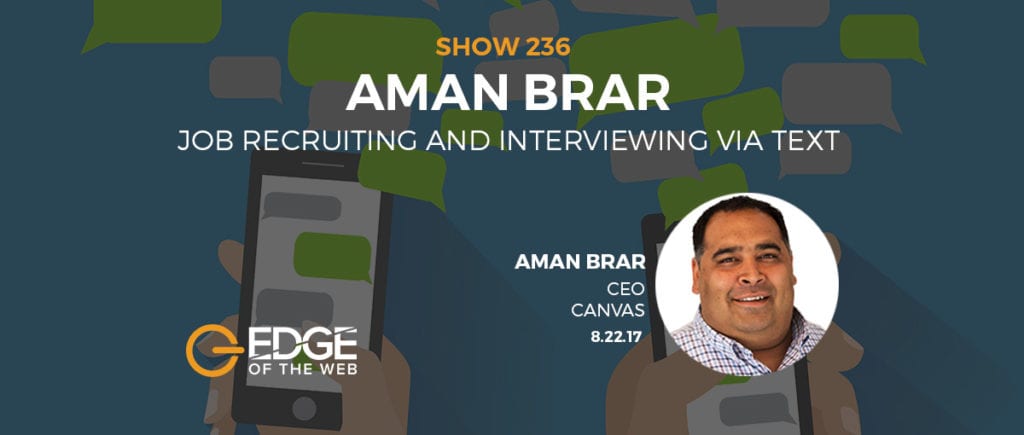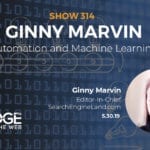Edge of the Web: interview with Canvas CEO Aman Brar
Job Recruiting and Interviewing via Text with Aman Brar CEO of Canvas, show 236, 8.22.17
Aman Brar is passionate about machine learning and human talent. It’s the fusion of these two elements that led to launch of Canvas, a text-based interview platform that is helping recruiters and candidates pre-screen and gather information before traditional interview phone calls. The technology is disrupting the talent industry in the most efficient way, explained Brar, chief executive officer at Canvas, on Edge of the Web podcast 236, Job Recruiting and Interviewing Via Text w/Aman Brar. In this episode Brar describes how texting is changing the hiring process.

Canvas launched June 13, following a short ramp up cycle that began in January 2017 with team building. Much of the leadership came from Indy-based Apparatus, where rapid growth and hiring created a need for such a tool–especially when a volume of interviews needed to be conducted and time was of the essence.
The demand and result of recruiting innovation
The reality is that traditional recruiting takes time. In one day, a recruiter could typically screen four to six candidates. Canvas, said Brar, helps recruiters screen four times that amount. The talent industry is responding favorably to the platform; sixty days following the launch, Canvas is being used by 3,000 candidates and hundreds of recruiters who are exchanging tens of thousands of messages and even interviewing globally.
Why is Canvas catching on? Aman attributes part of the quick adoption to the speed of business today. To capitalize on quick openings in the market, “organizations need to have efficiencies established to get people involved quickly,” said Brar. “They can’t have long drawn out interview cycles.”
Canvas features: how the platform works
Factor in the rise of the gig economy, and you have a shifting talent landscape that is ripe for new processes and new ways of engaging. “It doesn’t hurt that everyone is tied to this [the smartphone],” said host Erin Sparks. Society has accepted mobile devices, and we’ve created a culture of notifications and systems vying for our attention.
Canvas is using this to its advantage, by facilitating communication among candidates and employers about the job, company, benefits and culture (and otherwise vet) before the initial conversation. The platform software:
- Creates candidate portraits and stores information about internal interactions, candidate social activity, job descriptions, benefit info and videos in a resource library.
- Sources information being inquired about (for example, benefits) and creates notifications for distribution.
- Can solely reveal skills by masking name and gender pronouns.
- Collects memorable answers and provides screenshots for quick reference.
- Takes notes and provides a transcript of the conversation.
- Provides analytics and methods to assess interactions.
Who’s using Canvas? Diverse industries
Perhaps the biggest surprise to Brar is just how broad the appeal and effectiveness is within the talent space. It’s not just software developers and engineers that are being recruited via Canvas. The platform is also initiating hiring conversations with welders, machinists, physical therapists, nurses, physicians, sales professionals as well. For many of these professions, hopping on the phone for a screening call in the middle of the work day isn’t efficient. But a quick text message is.
Ironically, efficiency isn’t being pursued at the expense of in person meetings. “We’re all about human to human interaction, but we’re using technology to make that happen,” says Brar. Making sure that the conversations are streamlined and productive is the focus–and understanding how to best approach talent.
“Companies need to meet talent where they are,” said Brar. “It’s just like how marketers have to meet customers where they are. Increasingly, it’s not on a 30 minute phone call with a recruiter. The goal is to understand if there’s a need to have that call–that’s where we see the market headed.”
And though technology is part of our future, Brar is focused on using it to empower humans. With Canvas in particular, “humans are still the center of the conversation/interaction, but it is supported with a super intuitive tool,” he said.
Listen to the full podcast or or download on iTunes!
Are you on the cutting edge of digital marketing? We want to hear your thoughts, insights and ideas about the digital space. Find out how to you can secure a guest spot on Edge of the Web.


